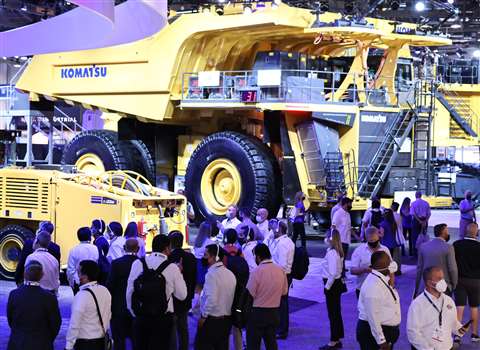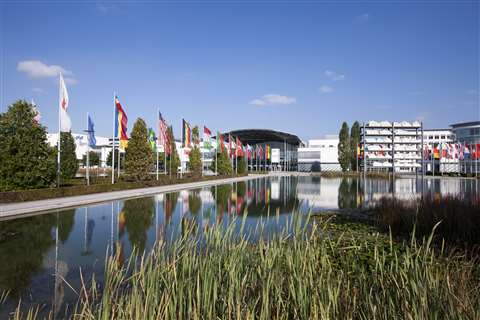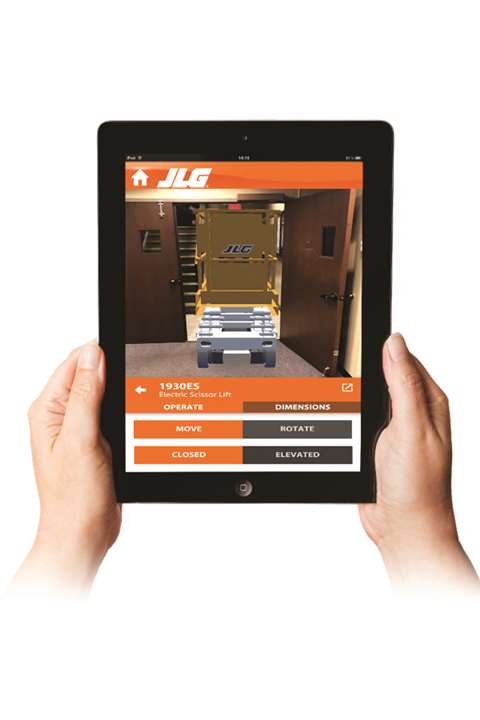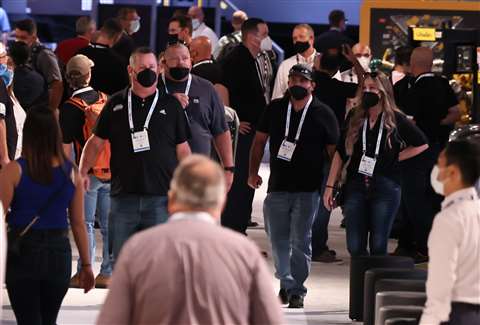How covid, carbon and construction tech is changing Bauma
12 October 2021
With exhibitors facing pressure to cut costs and carbon emissions and new technology enabling firms to try out remote marketing campaigns, Lucy Barnard finds out how the world’s biggest construction trade shows are evolving in a post-pandemic world
It may still be a year away, but already Messe München, the organisers of Bauma 2022 are busy reassuring exhibitors that they are taking every precaution necessary to keep them safe during the pandemic.
A promotional video on the Bauma website shows guests visiting the stands at the vast Munich exhibition hall conscientiously social distancing, applying generous dollops of hand sanitizer and wearing facemasks, all under the watchful eyes of women in white tabards who are there with the sole function of enforcing these measures.
Bauma 22 trade exhibition
“I think the hygiene measures are very well thought out,” one woman tells the camera. “There are disinfectant dispensers everywhere. There are people walking around who make sure masks are worn and that a safe distance is kept.”
“A trade fair is not replaceable,” another woman agrees. “Personal contact at a trade fair is not replaceable.”
It’s a clear message from the world’s largest trade show which in 2019 attracted more than 620,000 visitors with around 3,700 exhibitors from 63 countries.
But, with many companies around the world using the pandemic as a way to rethink the way they communicate with customers and colleagues, some have been taking a fresh look at how they participate in Bauma and other industry trade shows.
Bauma’s organisers have been doing everything they can to ensure mass participation, especially for the international customers. In April 2021, Messe München announced it was postponing the show which had been due to take place in April 2022, to October 24-30, in order to allow international visitors to attend.
“The show is fully booked, and the feedback is comparable to previous Baumas,” says Collin Davis, executive director of capital goods shows at Messe München. “A few companies will pause in 2022 but overall, we expect around about the same number of exhibitors – national and international.”
What’s the future of trade shows?
Nonetheless, several big-name companies have announced that they are pulling out. These include Volvo Construction Equipment, aerial lift manufacturer JLG industries and mining services company Metso Outotec. Caterpillar announced it would exhibit at the show through its German dealer Zeppelin Baumaschinen rather than taking its own stand, and JCB said it was “unlikely” to be exhibiting.
Many, of course, remain firmly committed to Bauma, while others say they have yet to make a final decision about participation and are still weighing up the benefits of attending compared with the cost savings and environmental benefits of staying home and opportunities for new marketing approaches.
Cost is certainly an issue. Bauma, for example, costs around €300 (US$346) per square metre to exhibit (for a minimum of 20 square metres), and then you have to factor in temporary buildings, hotels, employees, and machines. It can all add up to millions of Dollars for the biggest OEMs.
Those not attending next year point to the fact that sophisticated communication technology in the form of Zoom, Microsoft Teams, Google Meet and others has made it possible to stage virtual events far more effectively than would previously have been possible.
 Masked visitors attend MinExpo in Las Vegas - photo courtesy of NMA
Masked visitors attend MinExpo in Las Vegas - photo courtesy of NMA
“Covid-19 has accelerated new ways of working which has in turn changed customer behaviour,” says Paulina Ekestubbe, head of events and exhibitions in the EU and internationally, at Volvo CE. “Change was already happening but it has certainly prompted industries to adapt much faster.”
Instead, Volvo CE plans to launch what it calls “an all-channel marketing approach,” where everything from new product launches, to test drives to dealer conferences can be held both on-line and in person through smaller, more targeted local events.
In October, Volvo CE launched its ECR25 Electric compact excavator and L25 Electric wheel loader via a live digital press conference including a presentation from Volvo CE president Melker Jernberg.
The company has also transformed other physical events such as dealer conferences and key account conferences into digital formats since the pandemic hit and plans to continue to host them in the same format going forward.
Reducing carbon footprint
And, as part of its plan to reduce its carbon footprint, it is holding internal events remotely too. Since 2018 it has been holding its leadership summits online rather than at Volvo CE headquarters and increasing the number of people able to attend to 1,200.
“Our new approach reflects increasing demands being made to do business in a more sustainable manner and to reduce the company’s environmental footprint, which is just as much a factor,” says Ekestubbe. “We plan to have digital product launches to not only demonstrate a more sustainable approach but to also allow us to reach many more of our customers around the world.”
When asked how much money it would save by not blowing its marketing budget on taking exhibition space, entertaining, or accommodating teams of employees at the show, Volvo CE says the move is “less a case of saving money and more about shifting our focus to other activities.”
 The München Exhibition Centre in Munich - photo courtesy of München Company
The München Exhibition Centre in Munich - photo courtesy of München Company
The company added that it had not “officially” calculated the amount of carbon it would be saving by not attending.
“All our face-to-face activities are considered on a case-by-case basis and from there we decide what approach fits best,” says Ekestubbe.
Ekestubbe says Volvo CE adopted its new marketing approach after completing an In-depth study on market trends, customer behaviours and an analysis of other industries and how they have evolved before and during the Covid-19 pandemic.
“This allowed us to have a more holistic perspective, to examine how trends on customer behaviours are moving forward and work out how we might be part of that evolution,” she says.
However, looking to the future, Volvo CE is quick to point out that it has not ruled out participation in Bauma or other trade shows beyond 2022.
Arial lift equipment manufacturer JLG adds that its decision to step away from Bauma next year has been the result of employees around the world adopting more flexible working patterns. With fewer and fewer staff working regular office hours, the number of people able to commit to a week-long stay out of town are also declining.
 JLG announced this year it would not attend Bauma but would be creating more digital events to market its products
JLG announced this year it would not attend Bauma but would be creating more digital events to market its products
“Customer interaction has certainly changed in the wake of Covid-19, driving companies to think differently about marketing opportunities – both in the short- and long-term,” says Jennifer Stiansen, director of marketing at JLG. “This challenge has led JLG to explore new options outside of its traditional channels and marketing activities.”
“Even before the Covid-19 pandemic, we began looking for ways to build more customised marketing experiences for our customers,” she adds. “One of the things we have discovered is that there was an appetite in the industry for on-demand, immersive online experiences that would continue to have value well beyond the pandemic.”
Flexible working
“As nine-to-five workdays have become a thing of the past, flexible working is increasingly common, so we also have wanted to develop experiences that allowed users, regardless of time zone, the ability to experience JLG where and when they want, giving them the control to explore what was of greatest interest and of greatest benefit to their business on demand,” she says.
To meet this need, JLG has created its own ‘Access Your World’ platform, a sort of video game-like website where customers can walk around virtual job sites, inspecting pieces of equipment and seeing how it works.
Stiansen also agrees that virtual experiences will not completely replace face-to-face events such as trade shows. However, she adds that the company believes “smaller, more personalised, regional events will gain in popularity.”
In the other camp, US crane manufacturer Manitowoc is one of the many companies saying they are firmly committed to exhibiting at Bauma next year.
“The crane audience is a small nucleus of customers. Customers expect to see us at these events so they can learn about and compare our cranes against their needs versus the competition who are typically at these same events,” says Ion Warner, vice president of marketing and investor relations at Manitowoc.
“We’re not a company that can sell out of a catalogue. We don’t sell coffee mugs through the internet,” he says. “We’re talking about multi-million dollar products and frankly customers want to talk to the manufacturer in person before they commit. There is no substitute for seeing a customer first-hand and help guide them to the best lifting solution for their needs.”
Virtual trade shows
Although Manitowoc has been participating in virtual trade shows and launching new products this year on YouTube live, the company still believes in-person events such as trade shows are well worth their investment.
“In our view trade shows are an excellent venue to meet many customers from different regions at one time which lends itself to efficient marketing spend,” he adds. “Trade shows enable us to showcase our new products we are introducing to the marketplace as well as listen to the voice of the customer on a variety of matters.”
Warner adds that Manitowoc is “firmly committed” to reducing its environmental impact including reducing its greenhouse emissions by 15% by 2025. As part of this plan Warner maintains close control on even the ancillary costs associated with sending people to trade shows. However, he adds that marketing-related travel to meet customers as part of the normal sales process only account for a “very small” proportion of the company’s carbon footprint.
Stefanie Wieland, director for corporate marketing at construction equipment manufacturer Wacker Neuson Group, agrees. “Bauma still plays a major role for our customers to meet, exchange and get information about latest product developments,” she says. “Especially after a long period of little personal contact, our customers are more than open to visit Bauma.”
The Next Major Construction Trade Shows Around the World:
Bauma 2022 is due to take place on October 24-30, 2022, at the Messe München Exhibition Centre in Munich, Germany, having been postponed from its scheduled date of April 2022. The previous show was held in April 2019 and attracted more than 620,000 visitors and 3,700 exhibitors from 63 countries.
Bauma China 2022 is due to take place on November 22-25, 2022 at the Shanghai New International Exhibition Centre in Shanghai, China. The previous show was held, despite the pandemic, in November 2020, attracting 80,000 visitors and 2,867 exhibitors.
ConExpo-Con/Agg 2023 is due to take place on March 14-18, 2023, at the Las Vegas Convention Centre in Nevada, USA. The previous show was held in March 2020 and closed a day early due to the pandemic. The show attracted more than 130,000 registered visitors and around 2,300 exhibitors.
However, Wieland says that although Wacker Neuson’s customers are keen to return to exhibition halls, both the numbers of people attending, and the overall budget is being reduced.
“We talked to many of our customers including people from different industries and countries to get a broad picture. Additionally, we asked our own salesmen as well as our dealer partners. The result is a general “yes” to shows and events, but in a smaller scale than before the pandemic,” she says.
As such, although shows and events in 2022 represent a larger proportion of Wacker Neuson’s marketing budget compared with 2019, the overall amount is smaller, she says.
Certainly, in the past Bauma budgets have been a significant cost for companies. As well as the cost of renting exhibition space, firms must spend thousands of Euros on other associated costs. Build costs alone for a 60 square metre two-storey stand come out at around €45,000 (US$52,000) while staff accommodation for a team of around 50 people costs another €65,000 (US$75,000).
Although Liebherr says it is “too diverse and complex” to make any general statements concerning its overall marketing strategy, the German-Swiss equipment manufacturer attended MinExpo and is also firmly committed to attending Bauma next year.
“In 2022, Liebherr will be again among the largest exhibitors at the Bauma, with seven out of 13 product segments participating,” a company spokesman says. “The pandemic has revealed a lot of potential for alternative forms of communication and cooperation, but at the same time, it has also confirmed the enormous importance of personal encounters and face-to-face dialogue with customers, partners and business associates.
“In our opinion, trade fairs and similar events will remain important occasions to get in touch with and to personally exchange information with our international community, e.g. customers, partners and fans that we have all over the world,” she adds.
French arial work platform manufacturer Haulotte says it is still debating whether to attend Bauma.
In what it calls a “global” strategy, the company has, for many years, toned down its marketing activity around shows and exhibitions in order to focus on its own dedicated events. It is then up to each of the company’s 21 sales subsidiaries to decide whether and how to take part in local shows.
“At this stage everything is open,” says Caroline Prost, Haulotte’s operational marketing manager. “Nothing has been cancelled. Our events and marketing strategy is flexible and allows us to react quickly when necessary.”
To supplement this, the team has also put together some online one-to-one presentations for customers which the team has blended with its physical events.
“Digital events have to be carefully considered, because they do not allow the face-to-face discussion,” Prost says. “We believe in ‘phygital’ but only for dedicated subjects, or for the key moment of the Group communication.”
To that end, most show organisers have used the pandemic to accelerate plans to increase their digital offering to increase the size of the total audience while accepting that the number of people attending in-person is likely to reduce.
Virtual trade shows
MinExpo, the world’s largest mining show, which finally took place in Las Vegas in September 2021 after being postponed due to the pandemic the previous year, included live streaming of panel discussions while exhibitors uploaded product information and other information to the show’s website.
And with 90% of the 1,500 exhibitors previously booked for the 2020 show taking space and 22,000 visitors attending compared with a historical high of 40,000, organiser National Mining Association sees value in scaling back the size of the in-person event.
“We received feedback that this year was even more valuable than in previous years because, while the number of attendees was lower than in the past, those who did attend were serious about the event and came with a clear business focus,” says Ashley Burke, senior vice president for communications at National Mining Association.
 Face masks are becoming the norm for trade show visitors - photo courtesy of NMA
Face masks are becoming the norm for trade show visitors - photo courtesy of NMA
Expo Real, which took place in October 2021 in Munich, a year after it was originally scheduled, also included the option to attend remotely by buying a digital pass for €149 (US$172) rather than the €650 (US$751) for an in-person three day pass for the event.
The Association of Equipment Manufacturers (AEM) which organises ConExpo said it was “too early” to share its plans for ConExpo 2023.
Bauma says that for the first time, the 2022 show will include a “digital addition or extension,” which it hopes will appeal to those firms which would like to have a presence at the show without actually attending. The company says it is currently testing several models, such as the one being used at Expo Real, and plans to start marketing digital advertising opportunities at the start of 2022.
“The past months have pushed digitisation in general in an extraordinary manner,” says Messe München’s Davis. “As an organiser of trade shows worldwide we were practically forced to adapt really quickly to the new situation and find other and new ways to offer platforms for the industry. By doing this we learned which digital concepts are suitable for the market. So, by now we have some easy-to-use platforms which can be a helpful addition, or ‘extension’, to a show on site.
“I’m convinced that shows, where you meet face-to-face, are still the best networking platforms when it comes to business,” he adds. “However, I also think that nowadays, digital extensions really offer an additional value for exhibitors and visitors alike.”
But, at the end of the day, Davis says that visitors will only flock again to trade shows like Bauma in person if they can personally see value in doing so.
As well as the ‘official’ reasons for attending such as meeting customers and drumming up new business, exhibitors privately acknowledge that many visitors also attend because they want to informally search for a new job or because they like the idea of a week away from home visiting the sites of Las Vegas, New York or Munich. This may be especially true in the US where many employees see an annual trip to a trade fair as a welcome addition to typically small amounts of paid annual leave.
“Even though we all learned to meet via digital channels, present products online or even have parties in chat rooms, a face-to-face meeting, where you not only see your counterpart on a computer screen, is the best possible way of meeting and establishing business contacts,” Davis says.
“This is, by the way, also what our customers tell us practically every day and what the exhibitors of the shows and congresses, which have already taken place, have stressed.”
STAY CONNECTED



Receive the information you need when you need it through our world-leading magazines, newsletters and daily briefings.
CONNECT WITH THE TEAM








